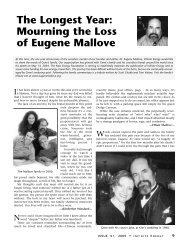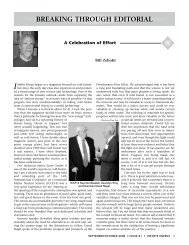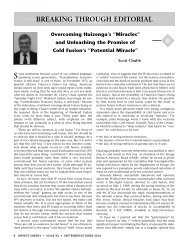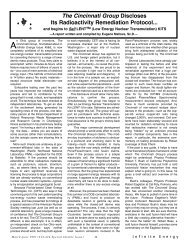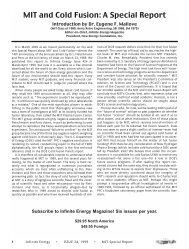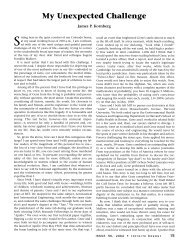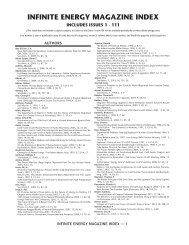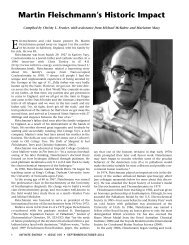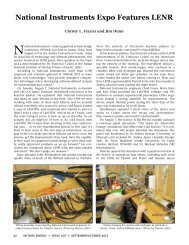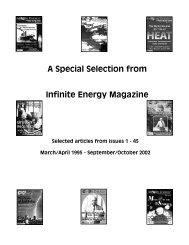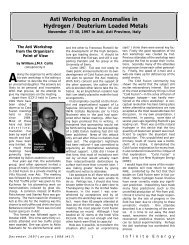Summary of ICCF14 - Infinite Energy Magazine
Summary of ICCF14 - Infinite Energy Magazine
Summary of ICCF14 - Infinite Energy Magazine
You also want an ePaper? Increase the reach of your titles
YUMPU automatically turns print PDFs into web optimized ePapers that Google loves.
the FPE. Additional measurements involving the system are<br />
absolutely critical. These include detailed measurements <strong>of</strong><br />
heat, with precise forms <strong>of</strong> calibration, which, in my opinion,<br />
should make use <strong>of</strong> the techniques developed<br />
by Mitchell Swartz. In addition, precision<br />
measurements <strong>of</strong> d-d, nuclear products,<br />
most importantly involving helium-4, are<br />
required. Understanding the relevance <strong>of</strong><br />
excess heat and helium-4 in these experiments<br />
is essential since the associated reactions<br />
have been shown to be dominant in the<br />
other FPE experiments.<br />
Information about a number <strong>of</strong> other<br />
important experiments was also reported.<br />
Vittorio Violante, from ENEA in Rome, Italy,<br />
presented an overview <strong>of</strong> the important work<br />
that has gone on in his institution, in collaboration<br />
with Energetics, SRI, and the Naval<br />
Research Laboratory. In their work, they have<br />
been focusing on the effects <strong>of</strong> changes in<br />
materials and the role <strong>of</strong> material structure in<br />
initiating the excess heat effects. In particular,<br />
although they have not been involved with<br />
using the kinds <strong>of</strong> nm-scale materials that<br />
Arata has used, they have used probes that are<br />
capable <strong>of</strong> investigating nm-scale effects. In<br />
examining the various kinds <strong>of</strong> materials that<br />
seem to be useful, they have found that high<br />
loading is necessary but not sufficient for creating<br />
excess power.<br />
They have identified two kinds <strong>of</strong> materials<br />
that have distinctively different forms <strong>of</strong><br />
behavior that create excess heat. They refer to<br />
these materials as type “A” and type “B”. The<br />
type “A” materials created excess heat efficiently<br />
(with reproducible results occurring<br />
75% <strong>of</strong> the time at SRI and 60% <strong>of</strong> the time at<br />
ENEA) but at reduced (20% Excess Power) levels.<br />
The type “B” materials also efficiently<br />
reproduced excess power but at significantly<br />
higher levels. In particular, in two instances,<br />
these materials had a coefficient <strong>of</strong> production<br />
(=excess power/input power) <strong>of</strong> 7 (or<br />
700%) and 5 (500%). More detailed analyses<br />
indicate that the materials that appear to create<br />
greater amounts <strong>of</strong> excess power have<br />
structures that appear to have greater crystalline<br />
order in the surface regions. On<br />
Thursday, Francesca Sarto presented a talk,<br />
“Electrode Surface Morphology<br />
Characterization by Atomic Force<br />
Microscopy,” which included a detailed discussion<br />
<strong>of</strong> an analysis <strong>of</strong> the power spectral<br />
density, associated with images <strong>of</strong> the surface<br />
<strong>of</strong> heat-producing and non-heat-producing<br />
electrodes. The power spectral density which<br />
is derived from a fourier transformation <strong>of</strong><br />
images <strong>of</strong> the surface that are taken using<br />
Atomic Force Microscopy, provides a way to identify patterns<br />
in the variations <strong>of</strong> the surface morphology.<br />
The associated decomposition shows that the improved<br />
performance associated with both type B and type A materials<br />
appears to be correlated with approximate ordering on<br />
Robert Smith, Jr.<br />
Charles Beaudette<br />
Takayoshi Nohmi<br />
the surface. Samples that do not give <strong>of</strong>f excess heat effectively<br />
have random forms <strong>of</strong> orientation on the surface,<br />
while samples that give <strong>of</strong>f excess heat have preferential<br />
forms <strong>of</strong> orientation. Although this analysis<br />
is preliminary now, the technique associated<br />
with the analysis seems to be sufficiently<br />
valuable that further work involving its use<br />
appears to be warranted. These kinds <strong>of</strong> studies<br />
<strong>of</strong> materials structure and materials characterization<br />
are unique and have not been<br />
carried out elsewhere. Information from<br />
them appears to be extremely important.<br />
Other effects involving experiments associated<br />
with particle beams, i.e. work by J.<br />
Kasagi and his collaborators from Tohoku<br />
University, were presented later in the week.<br />
Also, preliminary work involving attempts to<br />
repeat experiments involving potential<br />
forms <strong>of</strong> transmutation, associated with<br />
work done at Mitsubishi Heavy Industries by<br />
Iwamura and co-workers, was discussed.<br />
There was also an interesting study by<br />
Edmund Storms involving the apparent creation<br />
<strong>of</strong> X-ray and s<strong>of</strong>t gamma ray emission<br />
involving low amounts <strong>of</strong> electrical power.<br />
David Nagel stated at the beginning <strong>of</strong> the<br />
conference that one <strong>of</strong> the factors that has<br />
impeded progress in the field is the fact there<br />
is no complete theory that describes what<br />
has taken place. This is a useful comment,<br />
but it appears to reflect confusion about the<br />
potential role <strong>of</strong> theory and, to a degree,<br />
details about what constitutes useful theory.<br />
An important point is that no serious effort<br />
appears to have been undertaken concerning<br />
this last, basic question. On Thursday, I<br />
raised this issue in more basic terms. I suggested<br />
that there have been considerable barriers<br />
to understanding what is taking place,<br />
based on preconceived notions about “existing<br />
theories” <strong>of</strong> fusion and variants <strong>of</strong> these<br />
ideas that have been suggested that might<br />
have bearing on the FPE. I suggested that in<br />
the end, the only “meaningful” theory that<br />
will be accepted must incorporate the established<br />
language <strong>of</strong> physics, which I suggested<br />
must involve conventional quantum<br />
mechanics. Confusion about quantum<br />
mechanics and its role in theoretical descriptions<br />
<strong>of</strong> the relevant physics has played an<br />
important role in the fact that at the present<br />
time an accepted, theoretical view about the<br />
phenomena does not exist. As the relevant<br />
science becomes more well defined, I am<br />
quite confident that greater theoretical input<br />
will occur, and that this will help to resolve<br />
many <strong>of</strong> the questions associated with confusion<br />
about the relevant science.<br />
I only alluded to some important beam, transmutation and<br />
other results, which I will cover in more depth in Issue 82.<br />
Preliminary planning has already begun for ICCF15,<br />
which will be held in Rome, Italy in September 2009, sponsored<br />
by ENEA and chaired by Vittorio Violante.<br />
Photo by Duy Tran<br />
Photo by Marianne Macy<br />
Photo by Christy Frazier<br />
SEPTEMBER/OCTOBER 2008 • ISSUE 81 • INFINITE ENERGY 7



